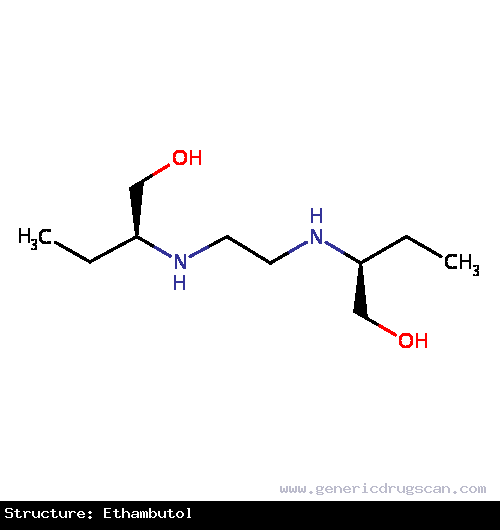Ethambutol Drug: Indication, Dosage, Precaution, Side Effect , Storage, Category Type and corresponding Brands - www.genericdrugscan.com
Ethambutol
Drug Status in USA : ApprovedDrug Status in Canada : Approved
pronunciation
pronounced as (e tham' byoo tole)
Why is this medication prescribed?
Ethambutol eliminates certain bacteria that cause tuberculosis (TB). It is used with other medicines to treat tuberculosis and to prevent you from giving the infection to others.
This medication is sometimes prescribed for other uses; ask your doctor or pharmacist for more information.
How should this medicine be used?
Ethambutol comes as a tablet to take by mouth. It usually is taken once a day in the morning. Follow the directions on your prescription label carefully, and ask your doctor or pharmacist to explain any part you do not understand. Take ethambutol exactly as directed. Do not take more or less of it or take it more often than prescribed by your doctor.
What are the precautions to be followed?
Before taking ethambutol,- tell your doctor and pharmacist if you are allergic to ethambutol or any other drugs.
- tell your doctor and pharmacist what prescription and nonprescription medications you are taking, especially antacids and vitamins. Antacids interfere with ethambutol, making it less effective. Take ethambutol 1 hour before or 2 hours after antacids.
- tell your doctor if you have or have ever had kidney disease, gout, or eye disorders such as cataracts.
- tell your doctor if you are pregnant, plan to become pregnant, or are breast-feeding. If you become pregnant while taking ethambutol, call your doctor.
What are possible side effects of this medication ?
Ethambutol may cause side effects. Tell your doctor if any of these symptoms are severe or do not go away:- loss of appetite
- upset stomach
- vomiting
- numbness and tingling in the hands or feet
- blurred vision
- inability to see the colors red and green
- sudden changes in vision
- skin rash
- itching
How to store the medication and dispose it of after its use later?
Keep this medication in the container it came in, tightly closed, and out of reach of children. Store it at room temperature and away from excess heat and moisture (not in the bathroom). Throw away any medication that is outdated or no longer needed. Talk to your pharmacist about the proper disposal of your medication.
Drug Category/Class
- Antitubercular Agents
- Antimycobacterials
- Drugs for Treatment of Tuberculosis
- Antiinfectives for Systemic Use
- Other drugs for treatment of tuberculosis
- Combinations of drugs for treatment of tuberculosis
| Prescribed | For use, as an adjunct, in the treatment of pulmonary tuberculosis. |
| Weight : | 204.3098 |
| Structure | Ethambutol |
 | |
| Formula | C10H24N2O2 |
Ethambutol has 118 Brands listed
Search Generic Drugs alphabetically
